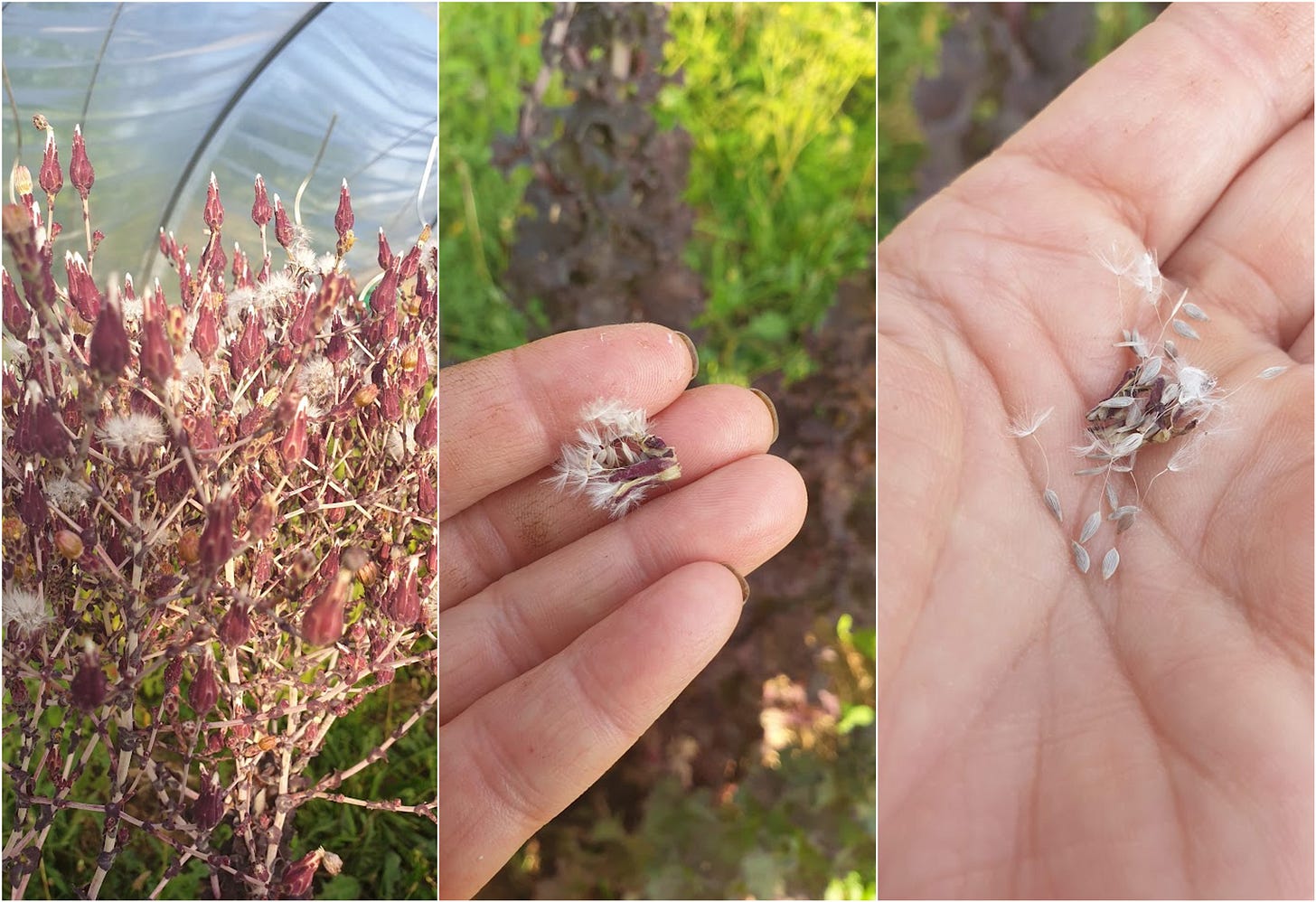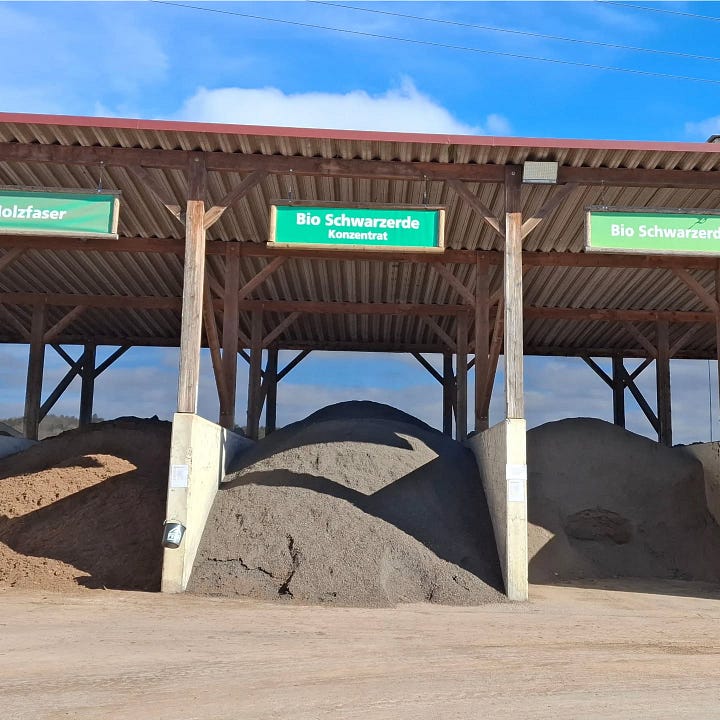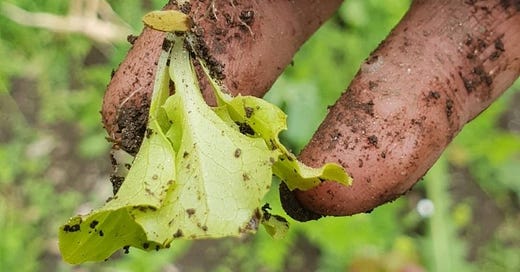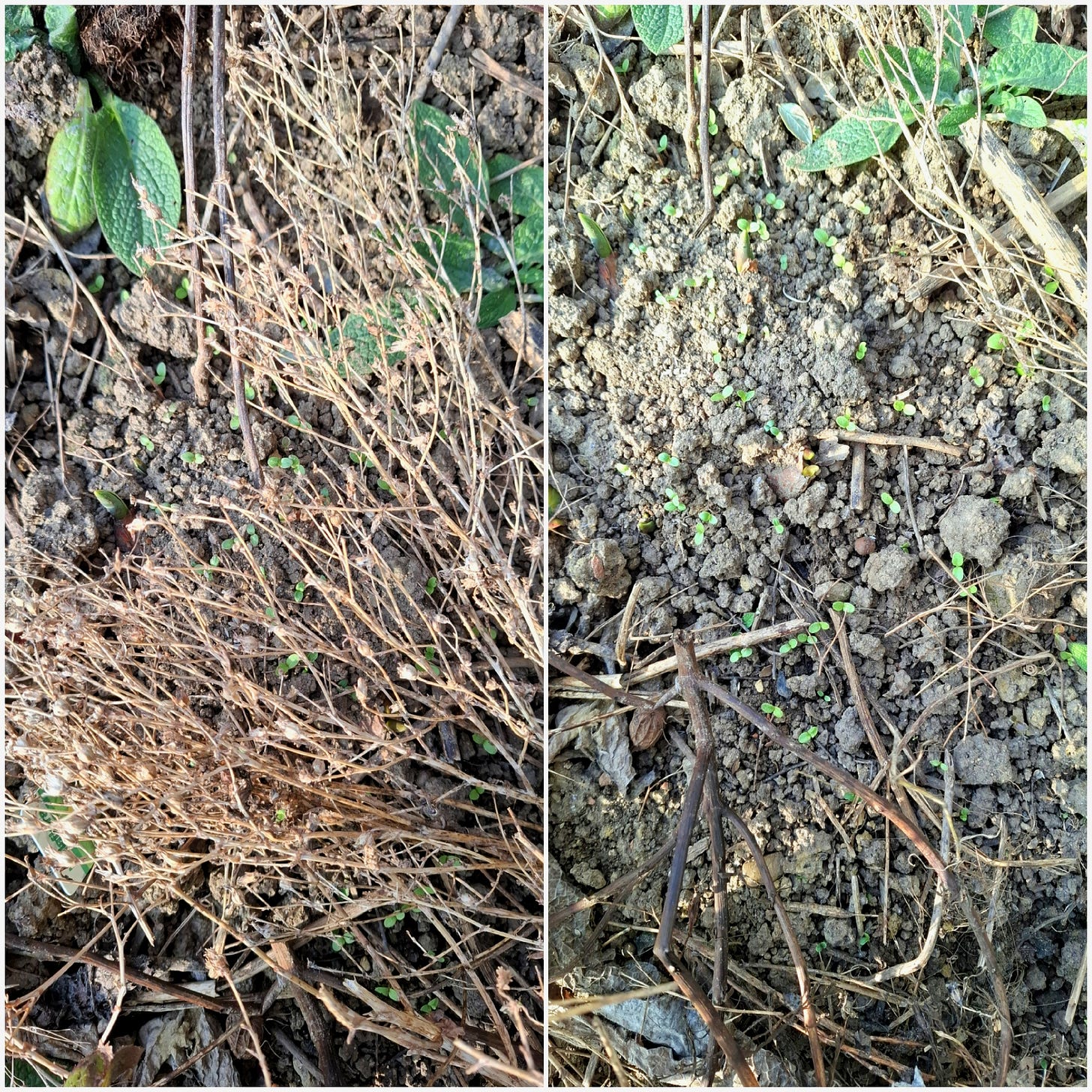As I said in my first newsletter, the garden will drive much of the content here, and that is exactly what happened today. This morning I discovered lettuce seedlings that must have sprouted yesterday while I wasn’t looking. They are protected under the dry stalks of last year’s lettuce, as you can see below in the “now you don’t see them, now you do” contrast. See the seedlings? The pairs of round, green leaves? (Please excuse the lack of color: the light is diffused here today and it is very dry.)
In moments like this, a wave of true, deep delight washes over me, the kind that arises when I receive an unexpected gift. It is a mix of surprise and gratitude with a good dose of confirmation for the trust I have in the garden and, ultimately, myself.
Here’s how I received this gift: Last November, after taking the seeds I needed from the dried lettuce stems, I tossed them onto a spot where I had planted tulip bulbs. Not only did the dead plant matter protect the bare soil a bit, but I knew there were still plenty of seeds I had missed. At some point, they would drop and sprout. That point was yesterday. Was it a gift to myself? A gift from the garden? Both.
For a bit of plant morphology (the life cycle of a plant), here are ripened seeds of a red-leaved lettuce variety on the plant and in my hand:

Lettuce (Lactuca sativa) is a so-called Korbblütler in German, “basket bloomer”. That’s a wonderfully apt description, because the seeds develop and ripen in the basket-like base of the flower bud. Each “basket” contains around 10 seeds with little white hairs at the top, similar to their botanical relative, the dandelion. Botanists call these hairs a “pappus” (ancient Greek, meaning “grandfather” to “beard”). When they open, they resemble parachutes, ready for the wind to transport them elsewhere. The gray teardrops in my hand (above, right) are the actual seeds.
When most of the fuzzy, white hairs appear, I cut off the plant and hang it to dry. Weeks or months later, I squeeze each full pappus to release the seeds onto a piece of newspaper. These I clean the old-fashioned way, pouring them back and forth between bowls on a breezy day. Most of the chaff drifts off in the wind and I have relatively clean seeds to store. Such a satisfying process!
My Self-Sowing Garden
A big part of low-input gardening is naturalizing plants in a semi-controlled manner, flowers as well as vegetables. Here is what reliably sows itself in my kitchen garden:
Spinach, chard, orache, lamb’s lettuce
Kale
Asian mustards and greens, including chum soy, mibuna and mizuna
Arugula/rocket (both perennial Diplotaxis tenuifolia and annual Eruca sativa)
Peppergrass (Lepidium densiflorum, a cress from the southern US), land cress (Barbarea verna)
Lettuce
Garlic chives (Allium tuberosum), Welsh onions (Allium fistulosum)
Coriander, leaf fennel, chervil, borage, calendula, marigolds
Other vegetables I have experimented with include brussel sprouts, radish and carrot. Brussel sprouts taught me a lot about when they wanted to start life (April) and radishes demonstrated what happens when they cross-breed themselves. Carrots need to be carefully selected to ensure good root development in the next generation. My experiments were, however, semi-successful with the small, round ‘Paris Atlas Market’.
I have also had snow peas self-sow, when ripe seeds fell to the ground and sprouted in late August. What a gift that was! That fall harvest of pea tips and a few pea pods for a stir fry taught me to sow in August for fall harvest. Heat-loving tomatoes and ground cherries will also self-sow, often too densely. I allow a few to grow and always get a late harvest, with the added plus that the self-sown tomatoes rarely get blight. The best types of tomatoes for this are cherry or currant types, because they tend to ripen earlier than beefsteak or paste tomatoes. (More on a self-sown tomato discovery another time!)
What do I mean by semi-controlled?
Semi-controlled means paying attention to when seed is ripe and deciding if the seeds are on their own of if I want to determine where they land on soil. If it is the latter, I cut the dying plant with ripe seeds and shake and scatter them where I want them to be.
One of my favorite moments in a self-sowing section of my first market garden was discovering just how much determination these seemingly delicate lettuce plants had in them:
My transplants could never achieve that strength and ffocus, because I have to disturb their roots twice: once, when I prick them out and move them to cells in a tray, and again, when I plant the cells out to the garden. Lettuce roots want to drill down into the ground and fast. No matter how early I plant them out, their roots are cramped in the confinement of the cell.
This understanding is also the reason I prefer to sow directly into the soil whenever possible.
My list for the next few days
I checked my garden journals from the last three years and am very pleased I’ve waited as long as possible for starting my first seeds. With all the gardeners around me talking about what they’re sowing and have already sown, it feels late and I become a bit anxious. It isn’t late at all, according to my documentation.
Yesterday, I picked up a soil mix for seeding and will be starting the following in the coming days:
bunching and bulb onions (especially ‘Tropea’!) as well as leeks
parsley
bulb fennel
kohlrabi and broccoli (cabbage and cauliflower, too, if you want)
head lettuce
peppers, chilis , eggplant
asparagus
ginger (sprouting tubers)


I won’t be sowing directly in the garden until the end of the month. Experience has taught me that sowing too early, when the soil is still cold, doesn’t really give me an advantage - unless I just need to get it done, because there is so much to do.
Thank you for reading this week’s newsletter! As always, I appreciate your support and interest. Each subscription is a boost of motivation! Let me know if there’s anything particular you’d like to see in a future newsletter. Comments are welcome and sharing is always helpful.
Have a good week!








I share your views on self-sown volunteer seedlings and their resilience compared to those deliberately sown. My strongest plants are often those that choose their own timing and place to live. Enjoy your garden gifts. 🌿
Lovely to read that you allow your garden to seed and give you the gift of life with a surprise element! It is true what you say about how vigorous and hardy the self sown seeds are. They know what they need to do more than any human intervention will! What is the temperature during the day in Austria at the moment?